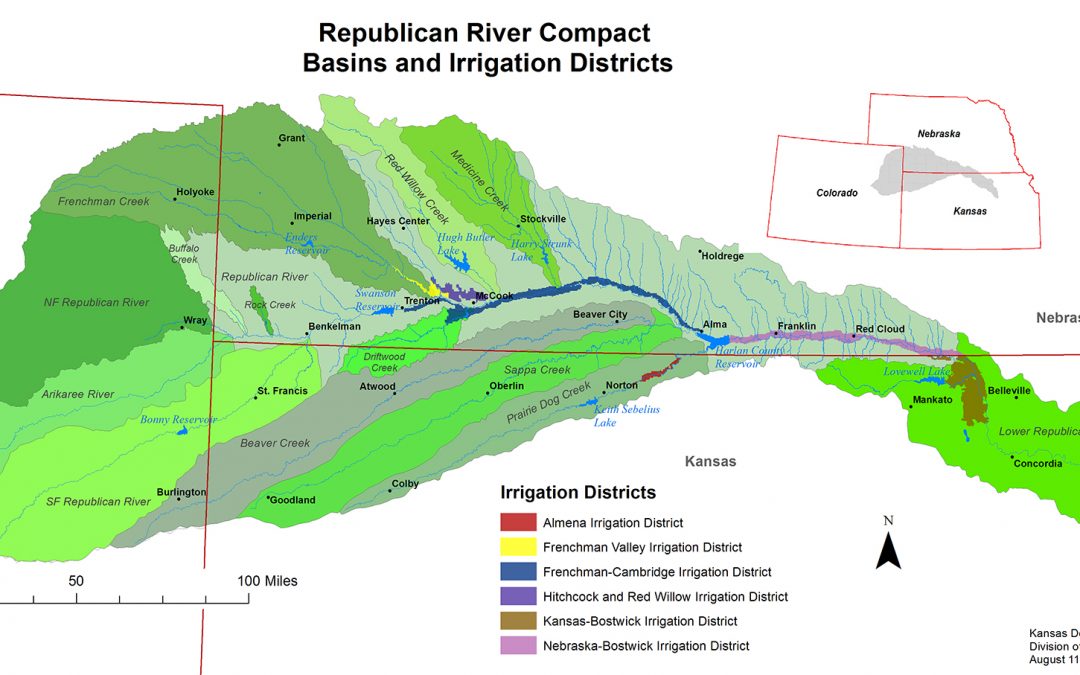This interview, which first appeared in the Rocky Mountain Farmers Union (RMFU) newsletter, is part two of a three-part series (read part one and part three) that we’re sharing here on the blog exploring groundwater and compact compliance in the Republican River Basin and the work of the Republican River Water Conservation District.
 RMFU director of communications, Bob Kjelland, visited with Timothy Pautler. Pautler has lived on the Pautler Family Farm his entire life. He is the third generation to operate the property his grandfather purchased in the early 1900s. He and his brother formed a partnership in 1976, which continues today. Together they use a three-year rotation of wheat, corn and summer fallow. Due to the decline in the aquifer, they have retired six pivots on the family property and eight on rented ground. Pautler is active in his community. He was on the Burlington Conservation Board from 1985 to 2001 during which the farm bill reintroduced the Conservation Reserve Program. He chaired the Resolutions Committee for the Colorado Association of Conservations Districts. And he served on the Colorado State Soil Conservation Board from 1999 through 2001. Since 1992 he has been on the Plains Ground Water Management District and represents the Kit Carson County Commissioners on the Republican River Water Conservation District (RRWCD). He is a member of the Colorado Master Irrigator Project Advisory Committee. Timothy is a graduate of Stratton High School. He married Elizabeth Stegman in 1975. They have three daughters and seven grandchildren. Here are Timothy’s responses to questions about the district.
RMFU director of communications, Bob Kjelland, visited with Timothy Pautler. Pautler has lived on the Pautler Family Farm his entire life. He is the third generation to operate the property his grandfather purchased in the early 1900s. He and his brother formed a partnership in 1976, which continues today. Together they use a three-year rotation of wheat, corn and summer fallow. Due to the decline in the aquifer, they have retired six pivots on the family property and eight on rented ground. Pautler is active in his community. He was on the Burlington Conservation Board from 1985 to 2001 during which the farm bill reintroduced the Conservation Reserve Program. He chaired the Resolutions Committee for the Colorado Association of Conservations Districts. And he served on the Colorado State Soil Conservation Board from 1999 through 2001. Since 1992 he has been on the Plains Ground Water Management District and represents the Kit Carson County Commissioners on the Republican River Water Conservation District (RRWCD). He is a member of the Colorado Master Irrigator Project Advisory Committee. Timothy is a graduate of Stratton High School. He married Elizabeth Stegman in 1975. They have three daughters and seven grandchildren. Here are Timothy’s responses to questions about the district.
Conservation is not a leading issue in your basin due to the Compact Compliance Pipeline. How does that work?
When the pipeline was completed and functioning, we started to hear comments like, “Now we can pump it ‘till it is dry.” The pipeline did give us all a false sense of security suggesting nothing else has to change. The perception was the economies of the communities can now continue as usual and the threat of shutdowns is taken care of. But in reality, our small communities are changing so slow we don’t even see it happening, especially in areas of the basin that never had sufficient saturate thickness to expect life to go on as usual, or forever.
Every county and management district has wells that have diminished over time. Wells that used to pump 800 to 1,000 gallons per minute are now pumping 200 to 500, or less. A safe statement would be, “Most wells in the basin do not have the yield they originally had.” It only makes sense given we have been pumping from a non-renewable resource for 50-60 years that there is less today than in the 1960s. The engineers tell us that we are using 6-7 gallons from the aquifer for every gallon of recharge. Our landscape has changed dramatically from the 1960s. Farming practices specifically have changed. We now leave as much residue on the soil surface as possible. Before, this same soil surface would allow more rain to run off and into sand creeks where water percolates into the aquifer. Today it is held in the immediate soil profile.
Conservation has always been an underlying effort, but the urgency to get into Compact compliance was paramount and trumped conservation. The fee assessment in terms of conservation has been a problem for the basin. For $14.50 per acre, a producer can pump all he wants up to his permitted amount. It is too bad we have not been thinking in terms of a per acre-foot charge all along. As mentioned before, in the beginning, we did not have the ability to have a fee assessment based on acre-feet pumped. The meters did not come into existence until about 2010. Meters alone will not create conservation, although the irrigators today do pay more attention to the amount pumped. They are required to stay within their annual appropriation.
Conservation has been attained in the areas where irrigated acres were retired. That unused water volume assures more water for domestic and livestock use. This is vital for these areas long term. Travel west of the Republican River Water Conservation District (RRWCD) boundary and you will hear of large ranches with very limited water resources. Pipelines have been installed using USDA cost-share dollars to move the water for miles. And now, even those pipelines are in jeopardy of not having enough water for livestock numbers to adequately make an economic enterprise work.
When the pipeline was completed, the RRWCD’s Conservation Committee started looking at ways to encourage meaningful conservation. They formed a subcommittee made up of members from all the Ground Water Management Districts. This committee, to date, has not come up with any answers. And, I might add, this is not from a lack of trying.
Our basin is very different north to south and east to west. Saturated thicknesses vary from having very little water left to those areas that still have an estimated 40-year supply. Soil types vary vastly, as well. We have good heavy soils that will support dryland farming and areas of sugar sand that without water becomes rangeland. It is a classic case of the “haves and the have nots” depending on where you are located. We are all human, and no one wants to limit their neighbor’s ability to have an economic gain. Admittedly, this is a tough issue to struggle with.
Another problem we are faced with is the fact that the RRWCD has no statutory authority to impose water use restrictions in the basin. That is the authority of the Ground Water Management Districts. By design, when the RRWCD was given statutory authority to help the state get into compact compliance, GWMD’s were very outspoken and insisted that the RRWCD should not be allowed to take over the authority that the management districts already had. These are some of the challenges in trying to achieve meaningful and measurable conservation.
I would hope that we in the Republican Basin, can come up with a fair and equitable solution that fits the needs of ALL water users in the basin. The list of water users has to include the municipalities, domestic users, commercial interests, and livestock folks. Finding agreement affects everyone, not just the ag irrigators. We all have economic interests that are affected by the discussions moving forward. The emotional part of the discussion stems from the fact that if we do nothing, ever so slowly, the water passes by our neighbors and we don’t notice or care until it is our turn. A restriction that imposes conservation on all water users happens immediately. The economic impact is immediate.
In the Republican Basin in Colorado, for $14.50 per acre, we can pump up to 30 inches per acre as our permitted amount. This, providing you are in an area where wells have the capacity to pump that amount. But it is kind of ironic that we are scared to death of anyone imposing a restriction in the Republican Basin and yet right across the Nebraska and Kansas state lines water users are managing their operations with restrictions and making it work. In Nebraska, producers are restricted to 13 inches per year; in Kansas, they are restricted to 11-18 inches per year depending on location. In both states, the producers have the flexibility to manage the allocation to fit their rotations. We can surely figure this out, can’t we?
Learn more about Colorado Colorado’s interstate compacts in Water Education Colorado’s Citizen’s Guide to Colorado’s Interstate Compacts and learn about groundwater across the state through WEco’s new Citizen’s Guide to Colorado Groundwater.


 Print
Print